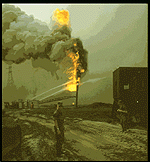Operations Using Sea Water

Photo by Jack Heller, USACHPPM.
TAB C - Fighting the Oil Well Fires
Before the systematic destruction of the oil fields began, Kuwaiti oil experts and executives from fire fighting companies predicted a worst case scenario of 100 to 125 wells destroyed.[219] The actual damage turned out to be seven to eight times greater. A huge amount of equipment and resources were needed to address this disaster. Officials knew, however, that the greatest single problem hindering the well capping efforts was that the Iraqi destruction of the Kuwaiti infrastructure, during the period of occupation, effectively eliminated Kuwait’s capability to undertake a damage control program.[220] This prompted a massive mobilization of well control resources from around the world. In all, more than 10,000 workers from 37 countries were called in to assist in well control. Resources necessary to extinguish and cap the wells included: 361 water lagoons, each with a 1 million gallon capacity; 450 Km of water piping; and more than 5,000 pieces of heavy equipment.[221] The first of this equipment arrived in country via a military airlift on March 15, 1991.[222]
The first firefighter companies to get involved with the Kuwaiti oil well fires were from North America. These first firefighters were the internationally known "Big Four": Red Adair of Houston, Boots and Coots of Houston, Safety Boss of Canada, and Wild Well Control, Inc., of Houston. Bechtel, Inc. of California provided all of the construction and logistical support for the project.[223] OGE Drilling-Kuwait, Inc. was given the initial responsibility for the coordination of the multiple fire fighting teams. Santa Fe drilling company joined in this effort as the number of fire fighting teams grew.[224] These companies began arriving in Kuwait on March 11, 1991. After several months of working almost exclusively with the four teams, the Kuwaiti Government reassessed the oil fire situation. It was determined that due to the slow pace of progress, additional support would be needed. By the end of August, fire-fighting teams from France, Hungary, China, Iran, USSR, and the UK had joined in the fire fighting efforts.[225]
By September 1991, the number of fire fighting teams in Kuwait had grown to 27. This led to a corresponding increase in the daily average of wells capped per day, from 3 in May 1991, to 8 in October 1991.[226] By October 10th, fire fighters had capped 566 of the roughly 750 damaged wells in Kuwait.[227] Table 1 shows the chronology of well capping and extinguishing.
Table 1: Chronology of Well Capping and Extinguishing[228]
| By May 1991 | 140 Wells |
| By July 1991 | 265 Wells |
| By August 1991 | 350 Wells |
| By September 1991 | 500 Wells |
| By October 1991 | 750Wells |
| Note: The last well was extinguished and capped on November 6, 1991. | |
The oil well fire fighters were quick to develop and implement innovative fire-fighting techniques. In early April 1991, the first fires were extinguished using seawater. The huge amount of seawater needed was brought to the fires from the Persian Gulf through a converted oil pipeline at a rate of 4,000 gallons per minute.[229] (see Photos 1&2). This technique was one of several that was used. Another method involved "raising the plume." In this method a metal casing 30 to 40 feet high was placed over the blown well head, thus raising the flame well above the ground. Liquid nitrogen or water was pumped into the casing, thereby reducing the oxygen supply to the fire (see Photo 3). Another method used was to drill additional "relief" wells that intersect the main blowout wells. This process involved redirecting some of the flow of oil and gas, thus reducing the pressure at the main stem.[230] The use of dynamite to relieve wellhead pressure was also useful on occasions. One of the more unconventional techniques used was the deployment of Mig-21 turbine engines mounted on old Soviet T-62 tanks. This method, devised by the Hungarian team, involved the use of high-pressure water and air directed at the burning well and proved to be fairly popular.[231]
Photo No. 1 Well
Extinguishing
Operations Using Sea Water

Photo by Jack Heller, USACHPPM.
Photo No. 2 Well
Extinguishing
Operations Using Sea Water

Photo by Jack Heller, USACHPPM.
Photo No. 3 Raising the
Plume Method

Photo by Jack Heller, USACHPPM.
As the number of oil wells on fire and gushing decreased over time, so too did the flow of oil into the air and soil. Figure 1 shows the capping and extinguishing progress over time, as well as the decrease in flow of lost oil.
The various fire-fighting teams had to overcome numerous obstacles in extinguishing and capping the wells. While many of these teams had previous experience in responding to accidental fires, few had ever dealt with deliberate sabotage. In addition to the inherent risks involved in the fire-fighting effort, other hazards posed serious threats. These included a tremendous number of unexploded ordnance left from coalition bombing and the ground war. Each new work site or building that the fire fighting teams planned to work on had to be cleared of such munitions before fire-fighting efforts could take place.[232]

Figure
1: Kuwait Oil Well Capping, Extinguishing, and Oil Flow
Chronology[233]
The rehabilitation of Kuwait’s oil industry, including well control and capping, repair of gathering centers, and the reconstruction of refineries exceeded $5 billion.[234] Kuwait spent an estimated $1.5 billion on the fire fighting effort alone.[235] Lost economic output for the period of occupation totaled about $10 billion.[236] Economic losses were also sustained from damage to Kuwait’s ports, national airport, electricity-generating systems, petrochemical and other industrial facilities, satellite system, telephone and telecommunications network, media installations and cultural sites. Conservative estimates of the total economic cost of the occupation to Kuwait are in the range of $30 - $50 billion.[237, 238]
| First Page | Prev Page | Next Page |